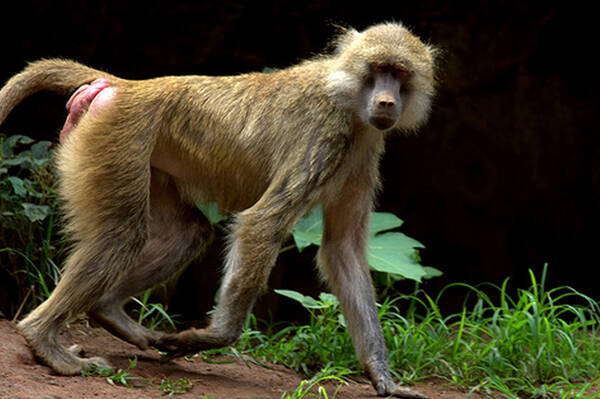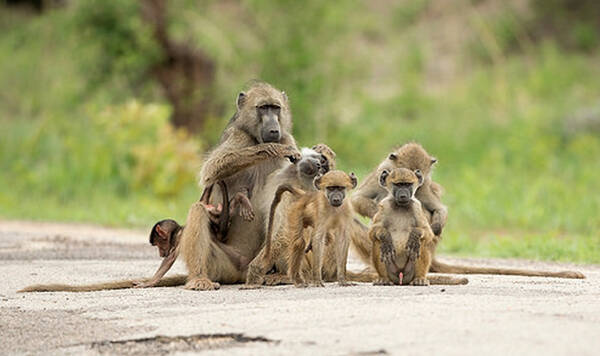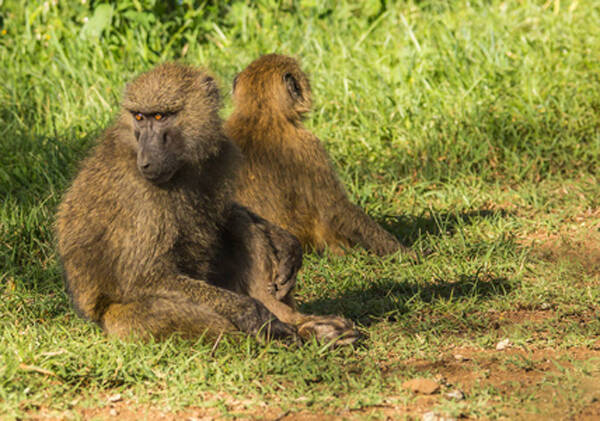Papio papio
IUCN
LCBasic Information
Scientific classification
- name:Papio papio
- Scientific Name:Papio papio,Guinea Baboon
- Outline:Primates
- Family:M.family Baboon
Vital signs
- length:50-114cm
- Weight:13-26kg
- lifetime:About 35 years
Feature
The facial skin is purple-black, the body hair is rough, and the hair color is reddish brown. There is significant geographical variation.
Distribution and Habitat
Distributed in Gambia, Guinea, Guinea-Bissau, Mali, Mauritania, Senegal. Uncertain presence: Sierra Leone.
Inhabits Sudanese savannas and the border with Guinean savannas. Vegetation cover in the region consists of deciduous woods and bamboo forests (42%), with other areas of land covered by non-wood plants. These non-forested areas vary seasonally, sometimes with tall grasses, and are flattened at other times of the year, resulting in very bare open habitats.
Appearance
The Guinea baboon is a smaller species in the same genus, weighing 13-26 kg, body length 508-1143 mm, and tail length 456-711 mm. The appearance is ugly, the color is strange, and the female animals are smaller than the male animals. Its head is large, with high brow bones and sharp edges. The eyes are dark and deep-set, the snout is very long, the snout of the female is slightly shorter, the face is flesh-colored, smooth and hairless. The limbs are very thick, and the hands and feet are black, suitable for walking on the ground. The tail is slender. The canine teeth on the male's upper jaw are long and protruding.
Guinea baboons have purple-black facial skin. The body hair is rough and the color is reddish brown, with significant geographical variation. Animals in the west have slightly lighter coats; animals in the east have darker coats, with red found in the brown parts. Guinea baboons are characterized by the same colored fur on their back, arms, cheeks and belly. Each hai
Details
Guinea Baboon (scientific name: Papio papio) is a smaller species in the same genus.

Guinea Baboons usually move on the ground during the day, are good at climbing rocks, and have the ability to climb trees. It is a social animal that likes to live in groups, sometimes forming large groups, each of which is composed of several families. If there is sufficient food source, the large group will automatically break up and form some stable small groups. Each group occupies a large territory and travels around the territory. Every day, they mostly go out for activities, foraging and drinking water along a fixed route, and return to a fixed forest to roost at night. Guinea baboons are wild and often fight in groups. If they encounter an intruder in the territory, the leader often takes the lead and rushes to the front, followed by other members. They are like fierce and tenacious soldiers, roaring loudly, throwing stones at the intruder, or biting with sharp canine teeth.
Guinea baboons spend about two hours a day eating, and the rest of the time grooming each other, combing their hair, and eating lice and other parasites they catch at any time, which not only keeps their fur clean, but also serves to connect the emotions between group members. When it is hot, they hide in a cool place to rest, play, and perform skills such as dancing and somersaults. At these times, the group will send out "sentinels" to guard the surroundings. Whenever wild beasts or birds of prey appear and danger comes, the "sentinels" will shout sharply to notify their companions to escape or defend against the enemy. This habit makes many other animals often stay near Guinea baboon groups in order to benefit from the signals they send.

Each family is led by the strongest, most sturdy, and most beautiful experienced male in the group. The size and sharpness of the male's canine teeth are important criteria for whether he can serve as the leader. Other members of the family include several underage males of lower status, several females, and cubs. The position of the leader is not easy to come by, nor is it a lifetime system. Once a smarter and stronger male animal appears in the group, it will challenge the position of the leader. After a fight, the winner can continue to serve as the leader.
In the baboon group, the social hierarchy is very strict, which is caused by the survival competition of the jungle in nature. In order to avoid unnecessary fratricide and fighting within the group, unite to resist the enemy and ensure the smooth growth and development of the offspring, the members of the group naturally form a hierarchical psychology with their own characteristics. The status of each individual in the group is determined by its ability, charm, size, strength, gender, age and other factors. The members of the community usually live in harmony and share the joys and sorrows of life, but the division of labor is also very clear. The leader's position in the group is supreme, and the entire community must obey its command. It can give orders to members of the group, give priority to food, occupy female animals in estrus at will, and even mediate and adjudicate disputes between members. As long as it growls, other members will immediately bow their heads and obey; other members should show obedience when passing by the leader, and those who violate this will be severely punished; when resting and eating, the leader should sit in the middle, etc. Female animals that have just given birth and their cubs also have a higher status in the group, and they are specially cared for and protected in terms of movement and feeding. Even when playing, female animals with cubs will not be attacked by other members. When the group moves, the leader often leads the team in front, followed by female animals and young male animals, female animals with cubs in the middle, and finally other stronger male animals in the rear.
Guinea baboons are omnivorous animals, but they mainly eat plant-based food. The leaves, fruits, rhizomes, barks, and sap of various plants, as well as many insects and larvae such as locusts, termites, and ants are all its favorite foods. Other animal foods such as scorpions, reptiles, and bird eggs can also satisfy hunger. It even preys on birds, hares, and small antelopes. When catching prey, it does not sneak up on the prey in a stealthy manner, but acts as a whole and uses a large encirclement method to hunt. Sometimes it also goes to orchards and farmlands in groups to steal fruits, cereals, and other crops, or to garbage dumps near residential areas or military camps to forage, ignoring the intimidation signs used by people. When discovered and driven away by people, some even throw stones to attack people, sometimes forcing people to use more severe means to repel these uninvited guests. Guinea baboons eat for two or three hours a day.

Guinea baboons have irregular estrus periods and reproduce once a year. When females approach ovulation, the pink skin in the anal genital area becomes swollen and rounded. This swelling usually lasts 13.2 days. At other times of the cycle, the skin in the anal genital area has a wrinkled texture. The gestation period of females is about 184 days, and only one cub is born per litter. The weaning period is about 420 days. The body hair of the newborn cub is black, and only the face, ears and buttocks are red. After birth, the female beast holds it in one hand and lets it hold the nipple to suckle. However, the cub spends more time under the female beast's abdomen. A few hours after birth, it must learn to hold the female beast's belly with its hands and run around with the female beast, especially when the female beast flies away quickly to avoid danger, it must hold the female beast's belly hard to avoid falling. When it grows up, it can ride on the back of the female beast. Sometimes it runs away from the female beast and plays nearby, but it will soon be called back by the female beast to avoid getting lost. When the cub can run and jump, it follows the female beast and often likes to grab the female beast's tail.
Half a year later, the female beast weans the cub and tries hard to drive away the cub that keeps screaming around it. However, these immature cubs will be cared for and guided by an elder in the group until they can live independently. The cubs reach sexual maturity at the age of 5-7, and the average life span is 35 years.
The leopard, the natural enemy of the Guinea baboon, has almost disappeared in its habitat. Its main threat comes from humans. The expansion of farmland is invading its natural habitat. Because baboons also dig crops, they are often driven away or even hunted by local people as pests. The World Conservation Union has classified the Guinea baboon as an animal with a conservation status of Near Threatened.
Listed in the World Conservation Union (IUCN) ver.: 2008 Red List of Primates - Near Threatened (NT).
Protect wild animals and stop eating game.
Maintaining ecological balance is everyone's responsibility!








